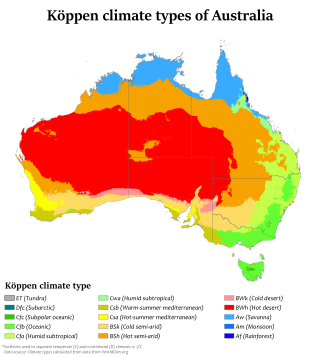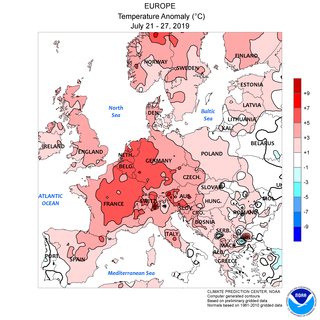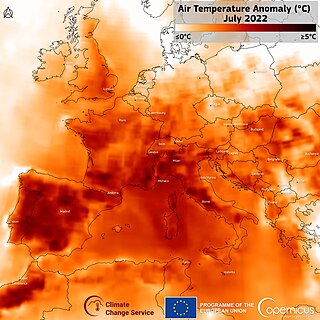
A heat wave or heatwave, sometimes described as extreme heat, is a period of abnormally hot weather. A time period of five consecutive days is often used to define a heat wave but the exact definition of a heat waves can vary for different countries. A heat wave is usually measured relative to the usual climate in the area and to normal temperatures for the season. Temperatures that humans from a hotter climate consider normal, can be regarded as a heat wave in a cooler area. This would be the case if the warm temperatures are outside the normal climate pattern for that area. High humidity often occurs during heat waves as well. This is especially the case in oceanic climate countries. Heat waves have become more frequent, and more intense over land, across almost every area on Earth since the 1950s, the increase in frequency and duration being caused by climate change.

The 2003 European heat wave saw the hottest summer recorded in Europe since at least 1540. France was hit especially hard. The heat wave led to health crises in several countries and combined with drought to create a crop shortfall in parts of Southern Europe. The death toll has been estimated at more than 70,000.

Adelaide, the capital city of South Australia, has a Mediterranean climate, with mild wet winters and hot dry summers.

The 2006 European heat wave was a period of exceptionally hot weather that arrived at the end of June 2006 in certain European countries. The United Kingdom, France, Belgium, the Netherlands, Luxembourg, Italy, Poland, the Czech Republic, Hungary, Germany and western parts of Russia were most affected.

The climate of Sydney, Australia is humid subtropical, shifting from mild and cool in winter to warm and occasionally hot in the summer, with no extreme seasonal differences since the weather has some maritime influence. Though more contrasting temperatures are recorded in the inland western suburbs, as Sydney CBD is more affected by the oceanic climate drivers than the hinterland.

Australia's climate is governed mostly by its size and by the hot, sinking air of the subtropical high pressure belt. This moves north-west and north-east with the seasons. The climate is variable, with frequent droughts lasting several seasons, thought to be caused in part by the El Niño-Southern Oscillation. Australia has a wide variety of climates due to its large geographical size. The largest part of Australia is desert or semi-arid. Only the south-east and south-west corners have a temperate climate and moderately fertile soil. The northern part of the country has a tropical climate, varying between grasslands and desert. Australia holds many heat-related records: the continent has the hottest extended region year-round, the areas with the hottest summer climate, and the highest sunshine duration.

Extreme weather events in Melbourne, Australia have occurred on multiple occasions. The city has experienced a number of highly unusual weather events and extremes of weather. An increase in heat waves and record breaking temperatures in the 21st century has led to much discussion over the effects of climate change in the country.

Launceston, Tasmania has a cool, temperate climate, with four distinct seasons. The city is located in the Tamar Valley in Northern Tasmania and is surrounded by many large hills and mountains. With this type of topography, Launceston's weather patterns can change considerably in a short period.

Europe is generally characterized by a temperate climate. Most of Western Europe has an Oceanic climate, in the Köppen climate classification, featuring cool to warm summers and cool winters with frequent overcast skies. Southern Europe has a distinctively Mediterranean climate, which features warm to hot, dry summers and cool to mild winters and frequent sunny skies. Central-eastern Europe is classified as having a humid continental climate, which features warm to hot summers and cold winters.
The Australian summer of 2012–2013, known as the Angry Summer or Extreme Summer, resulted in 123 weather records being broken over a 90-day period, including the hottest day ever recorded for January on record, the hottest summer average on record, and a record seven days in a row when the whole country averaged above 39 °C (102 °F). Single-day temperature records were broken in dozens of towns and cities, as well as single-day rainfall records, and several rivers flooded to new record highs.

The 2013 extreme weather events included several all-time temperature records in Northern and Southern Hemisphere. The February extent of snow cover in Eurasia and North America was above average, while the extent of Arctic ice in the same month was 4.5% below the 1981–2010 average. The Northern Hemisphere weather extremes have been linked to the melting of Arctic sea ice, which alters atmospheric circulation in a way that leads to more snow and ice.
The summer of 2014 in Sweden was unusually warm, especially in the northern parts of the country. July was the warmest ever month on record in the north-west.

The 1995 British Isles heatwave occurred between late July and late August. It was part of one of the warmest summers recorded in the UK, and one of the warmest Augusts ever recorded in many locations around the UK, as well as being one of the driest summers ever recorded in the UK; many weather stations recorded the summer of 1995 as drier than, or comparable with, the summer of 1976. Ireland was also widely affected by the heatwave with temperatures reaching over 30 °C (86 °F) in some locations, as well as exceptionally low rainfall throughout the summer.

The 2018 Britain and Ireland heatwave was a period of unusually hot weather that took place in June, July and August. It caused widespread drought, hosepipe bans, crop failures, and a number of wildfires. These wildfires worst affected northern moorland areas around the Greater Manchester region, the largest was at Saddleworth Moor and another was at Winter Hill, together these burned over 14 square miles (36 km2) of land over a period of nearly a month.

The 2018 European drought and heat wave was a period of unusually hot weather that led to record-breaking temperatures and wildfires in many parts of Europe during the spring and summer of 2018. It is part of a larger heat wave affecting the northern hemisphere, caused in part by the jet stream being weaker than usual, allowing hot high-pressure air to linger in the same place. According to the European Drought Observatory, most of the areas affected by drought are across northern and central Europe. According to the World Meteorological Organization, the severe heat waves across the northern hemisphere in the summer of 2018, are linked to climate change in Europe, as well as events of extreme precipitation.
In 2018, several heat waves with temperatures far above the long-time average and droughts were recorded in the Northern Hemisphere: The earth's average surface temperature in 2018 was the fourth highest in the 140 years of record keeping. It is assumed that the jet stream is slowing down, trapping cloudless, windless and extremely hot regions of high pressure. The jet stream anomalies could be caused by polar amplification, one of the observed effects of global warming.

In late June and late July 2019 there were two temporally distinct European heat waves, which set all-time high temperature records in Belgium, France, Germany, Luxembourg, the Netherlands, and the United Kingdom.

From June to August 2022, persistent heatwaves affected parts of Europe, causing evacuations and killing tens of thousands. These heat waves were the deadliest meteorological events in 2022. The highest temperature recorded was 47.0 °C (116.6 °F) in Pinhão, Portugal, on 14 July.

In 2023, Europe had been affected by heat waves. The most significant of which was the named heat wave, Cerberus Heatwave, which brought the hottest temperatures ever recorded in Europe. Starting on 10 July 2023, the record-breaking Cerberus anticyclone affected many European countries, with the effects felt most severely in parts of Southeast and Southwest Europe such as Cyprus, Greece, Italy, and Spain. The private Italian weather website iLMeteo named the extreme weather event after the hound of Hades from Greek mythology, and although some reports link the naming to the Italian Meteorological Society, the society's president said that they "absolutely don't use it".















